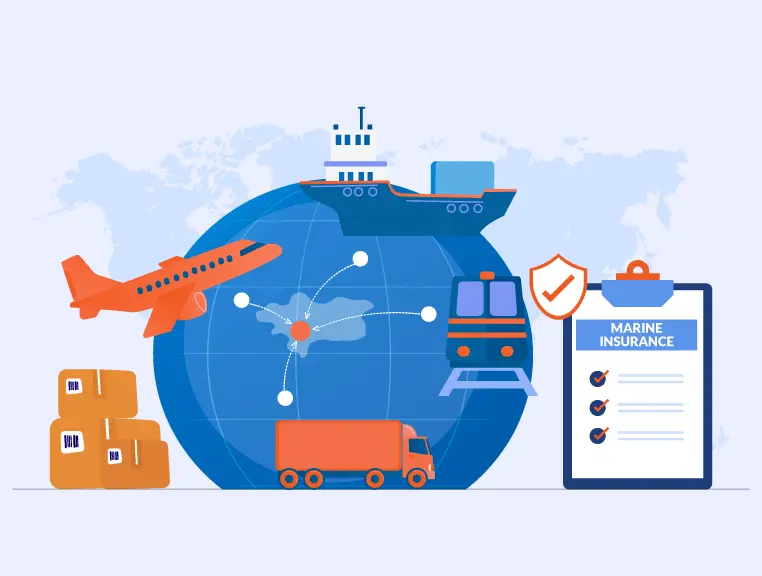In Marine Insurance, Inland Transit Coverage stands as a protective bulwark for goods navigating overland routes. This active insurance component shields shipments against a spectrum of risks, encompassing damages and losses during transportation. As cargo traverses roads and railways, this coverage ensures comprehensive protection. Clauses within Inland Transit Coverage meticulously address diverse perils, from collisions to theft. Understanding this dynamic facet is pivotal for businesses engaged in global trade, as it guarantees the continuity of supply chains by actively mitigating risks associated with overland transit. Dive into the essence of Inland Transit Coverage, safeguarding the flow of commerce across land and sea.
Inland transit marine insurance policy plays a crucial role by covering any loss or damage to the policyholder’s goods like raw materials, machinery, etc. during transit as per the contract. It offers cover to the policyholder’s business goods or personal belongings transported by land. Further, as per the requirement, it is feasible to categorize inland transit insurance coverage in marine insurance under the following heads:
Basic Risk Cover:
Inland Transit Insurance, guided by specific inland transit clauses, actively safeguards against losses or damages inflicted on the consignment by perils such as collision, fire, and lightning. Insurance companies incorporate these clauses, offering comprehensive coverage to mitigate risks during overland transport, ensuring financial security for transported goods.
All Risk Cover:
In Inland Transit Insurance, All Risk Cover is a vital component under marine cargo insurance. This comprehensive type of cover actively protects against a wide range of perils, ensuring robust financial security during overland transport. It covers a wide range of risks that can cause various losses or damages to specific goods.
Here, it is essential to note that inland transit insurance coverage only includes those goods which are being transported by land, like trucks, goods, trains, etc. It means sea and aerial modes of transport are not covered under the inland transit insurance policy. Usually, the policy offers coverage for goods that are being transported domestically.
Further, it is feasible to divide inland transit coverage in marine insurance under different heads, namely:
Overnight Vehicles Cover:
It is apt for those businessmen who may require their goods to store at night mostly in a vehicle. Overnight Vehicles Cover, a facet of marine insurance, is actively governed by specific inland transit clauses. Insurance companies incorporate these clauses to provide comprehensive protection for vehicles during overland transport, addressing risks and ensuring financial security for transport-related perils. While some insurers include the cover in their basic marine insurance plan, others charge an extra premium for this coverage.
Comprehensive Policy for Multiple Vehicles:
A Comprehensive Policy for Multiple Vehicles in marine insurance enables the insurance of numerous vehicles under a single cover. This option proves advantageous for those utilizing multiple vehicles in the transportation of goods, offering efficiency and consolidated coverage. It streamlines the insurance process, providing comprehensive protection for the fleet, ensuring financial security and ease of management in the dynamic landscape of marine transport.
Goods in transit (carrier’s) Cover:
In those situations, where a third party is involved in carrying goods, the carrier may not take responsibility for any loss or damage if it happens. Covering such liability through this insurance cover is feasible.
Inland transit marine coverage in a marine insurance policy is apt for those small and medium-sized business owners who do not require to import or export goods globally. The farmers purchased the policy to safeguard goods transported in their own vehicles. Types of cover this policy offers includes all types of goods, including finished goods, machinery, and raw materials.
Inland transit coverage in marine insurance becomes effective from the time the goods leave the storage place or warehouse terminating as soon as it delivers. Also, the inland transit insurance cover would remain active in those situations where there is a deviation, delay, or forced discharge. That is beyond the policyholder’s control.
Additional Read: For what Duration Do Inland Transit Insurance Clauses apply?
Case Study
Since 2010, K.Y Engineering has established a name for itself in the engineering sector. The company enjoys a wide spread of clients. As various risks can arise during the transportation of goods, the company is looking for a way to get coverage in case something untoward happens.
Solution
As K.Y Engineering has its clients situated in different parts of India. Essential for K.Y Engineering to purchase inland transit coverage in marine insurance to get protection in case something goes wrong.
K.Y Engineering can buy inland transit insurance to get financial coverage in case a misfortune happens. Here, the policy would offer coverage against total loss, partial loss, and related expenses when the goods are in inland transit. As the company deals only domestically, the inland transit coverage is an apt choice for it which would cover it against various perils like lightning, fire, etc.
As K.Y Engineering often transports goods by taking the help of a third party. Therefore, at the time of buying the inland transit cover, the company should disclose this fact to the insurer and opt for goods in transit insurance cover. This insurance policy helps in covering loss or damages as well, arising if you have used a third-party carrier.
In a situation, if using a third-party carrier, the third party is responsible for loss or damage that arises. You can opt for inland transit insurance cover which would help in covering third-party losses and damages as well.
Conclusion
It includes losses or damages, caused to the consignment by various perils like collision, fire, lightning, etc. It is possible to insure multiple vehicles under a single marine insurance cover. This policy is appropriate for you if you are using multiple vehicles for transporting goods.
In conclusion, Inland Transit Coverage in Marine Insurance is the dynamic guardian of goods in overland transit. From Basic Risk Cover to the comprehensive shield of All Risk Cover, this active insurance component ensures cargo resilience. The Overnight Vehicles Cover presents a tailored solution for safeguarding vehicles during the night. For those managing fleets, the Comprehensive Policy for Multiple Vehicles streamlines protection. Meanwhile, Goods in Transit (Carrier’s) Cover actively addresses risks tied to the transportation process. These facets collectively exemplify the versatility of Inland Transit Coverage, actively mitigating risks across diverse scenarios. Understanding these layers is paramount for businesses navigating the intricate landscape of global trade, ensuring the continuity of supply chains. As we wrap up, the active role of Inland Transit Coverage resonates as a steadfast protector, ensuring the secure and uninterrupted flow of goods across both land and sea.
Additional Reads: Who can buy Marine Insurance?
SecureNow- Enabling Cargo Insurance for Indian truckers.






